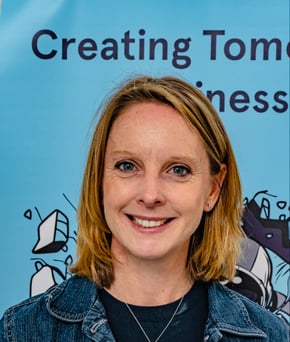The killer question of today's panel talk at AWS' Unicorn Day was ... if you’re scaling in a world where AI means everyone can do everything, do you get an engineer to do product management, a product manager to do design, or a designer who can vibe code?
This is no longer a hypothetical, it’s the decision many founders and leaders are making right now. AI has shifted the balance of skills in product development, collapsing the walls between roles that used to be distinct. The question isn’t if these roles blur, but how far we let them merge.
In the old model, the “three-legged stool” (one of my favourite metaphors!) of product, design, and engineering was about balance. Each discipline had a distinct craft, and collaboration was the magic. In today’s AI-augmented teams, those boundaries are dissolving.
With tools like Notebook LLM for customer interview synthesis, Lovable, Cursor, Replit for vibe coding, we can bring concepts to life in hours or less, meaning the core skills of each role are more accessible than ever. Designers can spin up working prototypes. PMs can vibe code a flow to validate an idea with users before a single sprint kicks off. Engineers can translate customer interviews into prioritised backlogs.
The result? Smaller, tighter teams where people “stretch” and move fluidly between discovery and delivery without the overhead of bigger teams.
Co-location becomes more valuable then too.
Why Vibe Coding Changes the Game
For PMs and designers: It bridges the gap between “what we imagine” and “what we can actually build,” helping teams make tangible decisions earlier.
For engineers: It’s a chance to validate whether an idea has legs before coding.
This shared prototyping fluency means cross-functional conversations are grounded in something visual, not a PRD. The faster you can loop from idea → prototype → feedback, the less you waste on polishing the wrong thing.
The AI Advantage: From Weeks to Hours
AI is already cutting cycle times dramatically:
-
Customer insight: AI-powered interview synthesis means we can understand patterns across dozens of conversations in minutes instead of days.
-
Prototyping: Vibe coding tools make it possible to generate usable visual flows instantly. And for those using Miro, check out the AI prototyping functionality - incredible!
-
Workflow acceleration: Engineers can auto-generate scaffolds for features, freeing more time for tricky edge cases.
That speed makes experimentation cheap, but in my opinion, it's still worth validating the problem space as even though you can do many experiments, waste is still waste. AI can help scale ideas, but it’s human insight that makes them worth scaling.
Where Humans Still Lead
For all its acceleration, AI has sharp edges:
-
Ethics and security: Malicious use of AI features, risky recommendations, or data leaks require human oversight.
-
Quality assurance: AI-generated outputs still need manual validation to avoid costly mistakes.
-
Context and empathy: AI can synthesise what was said, but it can’t watch a user’s facial expression mid-interview and spot the unspoken frustration.
Teams that combine AI’s speed with human judgment will outpace those chasing automation for its own sake.
So… Engineer in Product or PM Who Codes?
The answer might be: both.
-
Engineers stepping into product bring deep feasibility instincts and can move straight from concept to code.
-
PMs or designers who can code bring user empathy and the ability to translate that directly into something tangible.
In AI-era scaling, the most effective teams will be built around versatile product thinkers, whether they come from design, engineering, or product management, who can speak each other's language and use AI to collapse the gap between them.
If AI makes it possible for everyone to do a little bit of everything, the winning move isn’t to defend old boundaries. It’s to hire for curiosity, flexibility, and the ability to prototype ideas into reality and then let those smaller, stretchier teams run.
Because in the end, AI won’t replace the product team, it will just make it easier for the right kind of product team to win.

